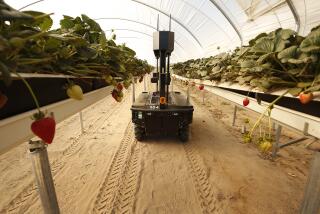Africa Struggles to Feed Itself, Fighting Intractable Foes : Agriculture: Beset by disease and infestation, the continent has had no ‘green revolution.’ It fights to preserve a fragile food chain while population soars.
- Share via
IBADAN, NIGERIA — There is a valley here that demonstrates why there has been no green revolution in Africa. It lies just north of the city, past the last village on the rutted track through the red soil, luxuriant with the dense foliage of the plants that feed and sustain the growing population. But around the second bend in the road, there is an ugly scar: Leaves of the plantain trees have been seared, as if by a giant blow torch, victims of the dreaded black sigatoka.
The fungus disease was brought accidentally to Central Africa from Latin America, and in 17 years it has spread ruin over millions of acres, finally reaching this remote valley 2,000 miles from where this plague started. About 60 million people in Africa depend on plantains for at least a quarter of their carbohydrates. Today, the disease represents the newest challenge to plant scientists struggling to preserve the fragile African food supply. An innovative solution is at hand, but it will not attract the same global attention as the high-yield dwarf varieties of rice, wheat and corn of Asia’s green revolution.
“One reason there is no green revolution in Africa is that so much of our research has to be directed to resistance-breeding and developing ways to protect the gains we have made,” said Laurence D. Stifel, director general of the International Institute for Tropical Agriculture here. The IITA is one of 13 international research facilities around the world that are at the very center of efforts to assure the survival of three-fourths of the world’s population.
These are the institutions best known for the grains that have helped food supplies keep up with population growth. Norman Borlaug won the 1970 Nobel Peace Prize for his work in Mexico on some of those developments. The research centers have played an equally decisive role in Africa, but without such spectacular achievements. Here the struggle is a rear-guard defense against plant disease and infestation.
Ask Stifel to identify the greatest achievement at the IITA, and his answer is a surprise. There are many achievements to talk about: high-yield, pest-resistant varieties of cassava; improved varieties of cowpeas that bring nitrogen to the soil and protein to the diet even in drought-prone areas, and minimum-tillage farming techniques that improve productivity while reducing weeds. And dozens more--all important achievements. But the project that Stifel talks most about is defense against the mealybug that was threatening destruction of Africa’s cassava, the basic food of millions of people.
A disaster of incalculable dimensions was in the making as the voracious mealybug attacked the cassava. African farmers have no money for chemical pesticides. IITA scientists knew there could be only one solution--a natural predator. They found it after a search over thousands of miles of remote areas of Latin America, the land where cassava first was grown. A parasitic wasp. A rapid-breeding program was instituted and millions of the insects were released, from airplanes in remote areas, from ground parties in accessible areas. “Villages step back from hunger not even understanding why the destructive mealybugs have disappeared,” Stifel reported.
The problems of Africa are so intractable that researchers, armed with the most advanced science and technology, have been frustrated over and over again. No where is that better illustrated than in the search for a way to expand livestock production. Animals are needed not just for the protein, but also for hides, for the manure that can be used as fuel and fertilizer and to pull plows and wagons in a region with only a few tractors. Much of the grasslands can be put to use only as feed for cattle. But vast areas of East and Central Africa are infested with ticks and tsetse flies that carry theileriosis and trypanosomiasis, that waste and often kill the herds.
There were great expectations, a decade ago, that a vaccine could be developed to protect the livestock. Development of a vaccine remains the priority at another of the great international centers, the International Laboratory for Research on Animal Diseases (ILRAD) on the outskirts of Nairobi in Kenya. But vaccines have proven incredibly elusive.
In the process of seeking vaccines, however, the scientists at ILRAD have made other advances of great consequence. From 10 years of work has emerged the first clear understanding of how the bovine immune system functions. “This new knowledge of bovine immunology opens the way to new research globally, an enormous contribution even to American farmers,” according to Jack Doyle, the Scotsman who is ILRAD director of research.
As the pursuit of vaccines continues, ILRAD has also moved ahead on another course, breeding cattle tolerant of trypanosomiasis. Scientists had worked a dozen years without much success using the cattle common is East Africa, the hump-backed Zebu, that were brought here around 2000 BC from Asia, by way of Egypt. Now they are making extraordinary progress using the Ndama cattle from West Africa, progeny of animals driven from the Middle East by way of Spain at least 7,000 years ago--cattle that are cousins to the longhorns that were carried to the American Southwest. Those prehistoric cattle runs have been traced and dated through ancient cave drawings. Unlike the Zebu, the Ndama is disease tolerant. But the animal still faces another kind of resistance: Farmers dislike its relatively small stature and reduced milk capacity.
The 13 international agricultural research centers, including IITA here and ILRAD in Nairobi, are independent, individually funded by governments, foundations and international agencies. They are loosely coordinated through what is called the Consultative Group on International Agricultural Research, based at the World Bank in Washington. The bank itself has proven the guardian angel of the program, expanding its contribution when other donors have lagged. The last pledging conference in November produced $240 million, representing an increase hardly equal to the rate of inflation, $35 million short of the budgets proposed by the centers. That has forced postponement for at least a year of expansion plans, including urgently needed new programs in vegetables and tropical forestry. Delays of that sort prolong the malnutrition that stalks so much of the developing southern hemisphere.
Some of the obstacles to progress are political. Donor governments in the West are cutting back on their investment in agricultural research at the very moment that the need is most urgent. American farmers continue to try to thwart any crop-development program perceived to create potential competition for U.S. exports. So it is that tropical soybean development, essential to addressing the protein deficiencies prevalent in all of Africa, was constrained by edicts from the U.S. Department of Agriculture mandated by Congress to protect the soybean farmers of the Middle West.
Another obstacle to progress is the weakness in extension services to deliver new technologies to the farmers. But it can be done.
Kwasi MacZormelo, 31, single, with three years of post-high school technical training, is one of the new generation of high-technology farmers of West Africa. But high technology is a relative term. “Chemical weed control is too costly, so I use my own strength,” he explained, as one of his co-workers applied a short-handled hoe to the field behind him. He farms four acres near Kumasi, Ghana. Small, intensely tilled farms have been proved best in these tropical areas. He harvests two crops of cowpeas, one of corn and is introducing one of Africa’s newest techniques, planting leucaena trees between crop rows. The fast-growing tree enriches the soil and reduces weeds with the shade of its leaves, which also serve as mulch, and its branches are useful for firewood, always in short supply.
The new plant varieties and growing technologies being used by MacZormelo have their origins in the international agricultural centers. In this case, the research began at both the International Center for the Improvement of Corn and Wheat in El Batan, Mexico, and IITA in Ibadan. Roberto Arias, a Savadoran agronomist, represents the El Batan center in Ghana, coordinating its research with the Ghana Grains Development Project sponsored by the government of Canada, and Ghana’s national institutions, including the Crop Research Institute in Kumasi. “We are trying to develop a methodology so that research and extension services are complementary,” Arias said.
This tenuous network for delivering new varieties and new technologies will be crucial in resolving the black sigatoka infestation affecting plantain trees. That is because the only realistic solution is to develop new varieties of plantains that are resistant or tolerant to black sigatoka, and then distribute the new plants to the vast areas impacted by the disease.
The IITA is nearing completion of plant development--five resistant varieties have been identified from a collection of more than 200 different varieties, but now they must be field tested to see if the fruit is acceptable. At the same time, a dozen other varieties have been crossed with disease-resistant stock to produce hybrids now being field-tested.
It is painstaking, tedious work, unspectacular, but just as important as the green revolution in the struggle to feed a global population that grows by 250,000 people a day, and to try to meet the basic needs of the 280 million Africans who live in absolute poverty.






